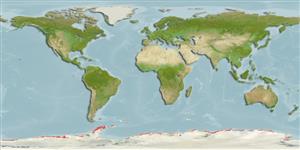>
Perciformes/Notothenioidei (Icefishes) >
Nototheniidae (Cod icefishes) > Nototheniinae
Etymology: Notothenia: Greek, 'notos', ou; νοτος, ου), from the south + Greek, 'e 'eutheneia',as or 'euthenia', as (ευθενεια, ας; ευθενια, ας), abundance (P. Romero, pers.comm. 01/16); neglecta: Named after Dr. Nybelin's feeling that this divergent form of coriiceps has been overlooked (Ref. 11892).
Environment: milieu / climate zone / depth range / distribution range
Ökologie
seewasser benthopelagisch; tiefenbereich 1 - 95 m (Ref. 11892), usually 1 - 90 m (Ref. 11892). Polar
Southern Ocean: coast of the Antarctic continent, Antarctic Peninsula, South Georgia, South Shetland, South Orkney Islands and Peter I Island.
Length at first maturity / Size / Gewicht / Alter
Maturity: Lm 30.0 range ? - ? cm
Max length : 45.0 cm SL Männchen/unbestimmt; (Ref. 11892)
Kurzbeschreibung
Morphologie | Morphometrie
Rückenflossenstacheln (insgesamt): 3 - 7; Rückenflossenweichstrahlen (insgesamt): 37-40; Afterflossenstacheln 0; Afterflossenweichstrahlen: 27 - 32. Caudal fin subtruncate or slightly rounded, emarginate in young. Coloration more spectacular compared to other nototheniids. Juveniles with a black blotch on distal end of pectoral fin.
Juveniles found in 1-10 m depth and possibly having a pelagic habit, adults in deeper water (Ref. 11892). Adults feed on crustaceans and fishes (Ref. 11892). Spawn once a year (Ref. 57661). Some information needs to be transferred from N. coriiceps to this species (RF).
Mature females may spawn for the first time from around 6-8 years of age (Ref. 71843).
Miller, R.G., 1993. A history and atlas of the fishes of the Antarctic Ocean. Foresta Institute, Nevada. 792 p. (Ref. 11892)
IUCN Rote Liste Status (Ref. 130435)
Bedrohung für Menschen
Harmless
Nutzung durch Menschen
Fischereien: kleinfischerei
Mehr Information
ReferenzenAquakulturAquakultur ProfilZuchtlinienGenetikElectrophoresesVererbbarkeitKrankheitenVerarbeitungNutrientsMass conversion
PartnerBilderStamps, Coins Misc.LauteCiguateraGeschwindigkeitSchwimmstilKiemenoberflächeOtolithsGehirngrößeSehfähigkeit
Tools
Zusatzinformationen
Download XML
Internet Quellen
Estimates based on models
Preferred temperature (Ref.
123201): -1.9 - -1.2, mean -1.7 °C (based on 342 cells).
Phylogenetic diversity index (Ref.
82804): PD
50 = 0.5078 [Uniqueness, from 0.5 = low to 2.0 = high].
Bayesian length-weight: a=0.00794 (0.00446 - 0.01415), b=3.25 (3.10 - 3.40), in cm total length, based on LWR estimates for this species & (Sub)family-body (Ref.
93245).
Trophic level (Ref.
69278): 3.3 ±0.2 se; based on diet studies.
Generation time: 12.1 ( na - na) years. Estimated as median ln(3)/K based on 2
growth studies.
Widerstandsfähigkeit (Ref.
120179): niedrig, Verdopplung der Population dauert 4,5 - 14 Jahre. (tm=7-8; Fec > 10,000).
Fishing Vulnerability (Ref.
59153): Moderate vulnerability (42 of 100).
Nutrients (Ref.
124155): Calcium = 19.2 [10.9, 42.1] mg/100g; Iron = 0.329 [0.160, 0.631] mg/100g; Protein = 17.6 [15.1, 19.7] %; Omega3 = 0.297 [0.146, 0.594] g/100g; Selenium = 12.7 [5.5, 28.9] μg/100g; VitaminA = 18.9 [4.2, 87.4] μg/100g; Zinc = 0.545 [0.375, 0.800] mg/100g (wet weight); based on
nutrient studies.
